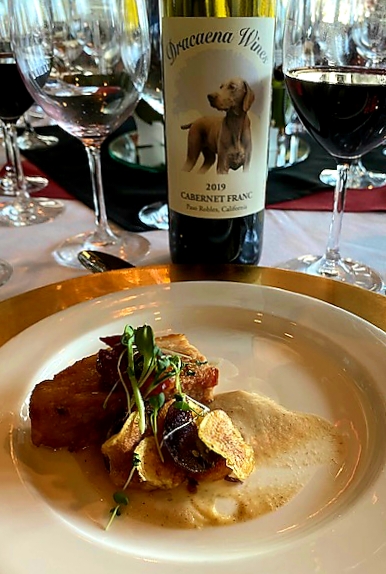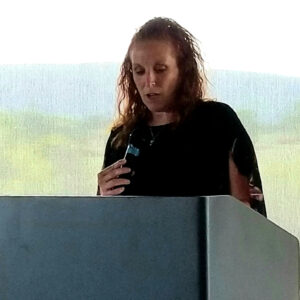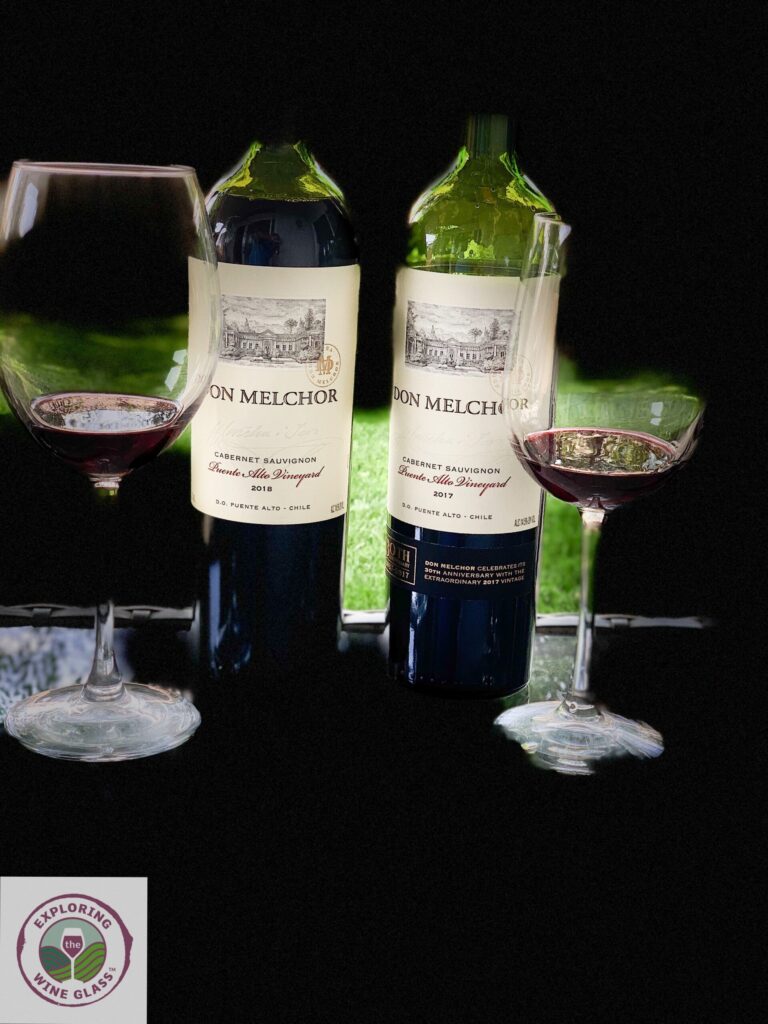I was honored to be asked to be a key note speaker at the International Cabernet Franc Competition sponsored by California Wines and Wineries. Below is my speech titled, “Cabernet Franc; Stepping out of the shadow of its Progeny.” Thank you to Michael Kelly for putting the event together and for the photo. (not sure what was up with my hair though! LOL) I was a bit excited right before stepping up to speak, since we just found out Dracaena Wines won Best of Class and Best of Show.
There is a popular quote from an anonymous individual that declares, “Children are great imitators. So give them something great to imitate.” It is every parent’s dream that their child does better in the world than they themselves. And Cabernet Sauvignon has done well. It is known as the king of red grapes and is the most widely planted red grape variety in the world. When people mention Cabernet, it is not Franc that comes to most people’s minds. But, times are changing and it is time for Cabernet Franc to step out of the shadow of its progeny and show how it is more than a blending grape.
In 2015, when we released our 2013 inaugural vintage, I that there was a wine holiday for everything. Sauvignon Blanc has a day, Cabernet Sauvignon has a day, even Carmenere has a day! And Merlot? It has a MONTH! Without Cabernet Franc, there would be no Cab Sauv, Merlot or Carmenere. So, I felt it was imperative that Cabernet Franc be recognized with an official holiday.
There are many times that while I am at a tasting event, people look at our bottles and say, “Oh, I love Cab!” When I come back with, “This is Cab Franc, not Cab Sauv are you familiar with it?” More often than not, the answer is “No.” And that is what Cab Franc Day is all about. Educating people about Cabernet Franc.
Two basic comments that I say to help introduce customers to Cabernet Franc is how Cab Sauv came about and how Cab Franc is similar to Cab Sauv. I explain that “one hot, wild and crazy evening as the fog was rolling in- there was seduction in the vineyard, Cabernet Franc and Sauvignon Blanc found each other and the result was Cabernet Sauvignon; a natural crossing. I explain that this isn’t true for many grape varieties; in fact many have been created in the lab, for very result driven reasons. Such an example is Petite Sirah; or Durif. Which came about when botanist Francois Durif crossed Syrah and Peloursin sometime around 1880. He was attempting to create a variety that was more tolerant to mildew.
Being called Durif, until it reached California, where it’s name was changed to Petite Sirah, it was very successful until the big bully Cabernet Sauvignon fell into the spotlight forcing the plantings of Petite Sirah to be ripped out and replanted with Cabernet Sauvignon. This, we have seen, is a trend for Cabernet Sauvignon; including doing it to its parent, Cabernet Franc.
In order to explain what they can expect on the palate from Cabernet Sauvignon, I continue with Cabernet Franc got around in the vineyards; he wasn’t a one variety kind of guy; he was quite the gigilo. Cab Franc is also one of the parents of Merlot and Carmenere. (as well as two now extinct grape varieties Morenoa and Hondarribi Beltza) And just like with human children, the parent gives a bit of themselves to their offspring. So when tasting a Cab Franc you can expect the body of the Cab Sauv, but the finish of a Merlot and just a hint of the spice that Carmenere is known for.
So where did Cabernet Franc get its start?
Cabernet Franc as a single varietal began in southwest France sometime in the 17th century with Cardinal Richelieu’s love for the grape. He was so enamored that he transported vine cuttings from the Libourne region in south-west France, to the Loire Valley. Here, it has been growing and thriving ever since and plays a leading role rather than blending in the shadows as it does in Bordeaux. The day, December 4th, was chosen as Cab Franc Day to remember Cardinal Richelieu’s legacy, – the anniversary of his death.
Loosely translated, Cabernet Franc is Latin for “black vine of France.” After Richelieu introduced Cabernet Franc to the region, an abbot named Breton ( actually a synonym for Cabernet Franc today) planted cuttings of these vines at the Abbey of Bourgueil. It is here that Cabernet Franc found its place having its first notable appearance in the 1600’s.
Today, plantings of Cabernet Franc are found throughout Europe, in addition to the right bank of Bordeaux, it is widely planted in Anjou Saumur and Touraine in the Loire Valley, northeast Italy, and Hungary. Plantings of Cabernet Franc can be found in Argentina, Canada, and China. In the United States there are plantings in California, Washington, New York, Colorado, and Virginia, among other places.
Returning to the statement of Cab Sauv being the bully in the vineyards. Over the past ten years in California, Cabernet Franc has decreased in tons harvested by about 5,000 while Cabernet Sauvignon has increased by over 200,000 tons.
And it’s not just Cabernet Franc tonnage decreasing. In 2013, of Cabernet Sauvignon accounted for 11.2% of the total crush, while in 2021 it accounted for 15.3%. So what effect does that have for us Cab Franc lovers and producers? The prices have skyrocketed. The price of Cabernet Sauvignon per ton has increased 24% since 2011, whereas the price per ton for Cabernet Franc has skyrocketed 105% over that same time period.
As Cabernet Franc’s popularity increases, there are more and more producers making varietal Cabernet Franc every vintage, we need to let more people understand how it differs from its progeny. And a good way to do this is through Cats in the Cradle by Harry Chapin. Now bear with me, because as a retired educator, it’s all about making the connection with the student and the song could have been written for the relationship between father and progeny .
My child arrived just the other day
He came to the world in the usual way.
Cross Pollination is the usual way for this Father and Son relationship.
Cabernet Sauvignon is the son of Cabernet Franc. According to Jancis Robinson in The Oxford Companion of Wine it is “The world’s most renowned grape variety for the production of fine red wine. And it is here solely because of a chance wind that occurred during the 17th century in southwestern France.
My son turned ten just the other day
He said, “Thanks for the ball, Dad, come on let’s play
While Cabernet Franc was busy in Bordeaux being a team player and becoming one of the most renowned blending grapes, his son, Cabernet Sauvignon was making a name for himself. Its popularity gained due to its ease of cultivation, its thick skin and extremely hardy vines. Cabernet Sauvignon can grow in a variety of climates and tends to be one of the last major grape varietals to bud and ripen. (typically about 2 weeks after its father)
“What I’d really like, Dad, is to borrow the car keys
See you later, can I have them please”
After some time, Cabernet Sauvignon variety began to be the vine of choice of winemakers. They were looking for more durable plants that were less temperamental and easier to grow. It became the most powerful grape in the Bordeaux region. What was there not to like? The grape had fantastic tannic structure allowing the winemakers to produce a wine that would age and evolve for years in bottle. The wine loved oak and began taking on new flavors. It was a full bodied wine with the right amount of acid and was perfect with food.
I said, “I’d like to see you if you don’t mind”
He said, “I’d love to, Dad, if I can find the time
Once Cabernet Sauvignon began to gain a name for itself, it made its way over to the New World and was planted in many areas. But in 1976, in the now historical Judgement of Paris, it was a little known wine from Stags’ Leap in the Napa Valley that beat out the top Bordeaux Chateaus in a blind taste test and turned Cabernet Sauvignon into the rockstar that left its father behind and has never looked back.
So while Cabernet Franc was being the workhorse, Cabernet Sauvignon was taking the spotlight. Just like the song, the son grows apart from his father and goes on his own path. But in the end, the father returns with a better understanding of what it takes to be a success in life. And as the vintages pass by, people are learning that Cabernet Franc has so much to offer they are going to want to spend time with it.
In the vineyard, Cabernet Franc offers the vineyard manager some relief from weather concerns as compared to its offspring. There are significant differences between the two vines. Clusters are tighter than Cabernet Sauvignon due to the greater berry set.
Cabernet franc berries are thinner-skinned, typically ripen earlier and have lower overall acidity than Cabernet Sauvignon. It is more cold tolerant and tends to survive colder winters, however is more susceptible to being damaged by Spring frosts. Although a lot is dependent on farming practices, Cabernet Franc is usually fruitier and has more of a tendency to be less tannic. But don’t let this fool you, Cabernet Francs are capable of aging just as its offspring, gaining more complex notes as it spends more time in bottle.
And very importantly, as the climate changes, Cabernet Franc, with its inherent tannic structure, good acidity and low alcohol is the perfect grape to continue to excel as it will not experience any distortion of varietal character. The same can not be said of Cabernet Sauvignon. So,
The cat’s in the cradle and the silver spoon
Little boy blue and the man in the moon
“When you coming home, Cab Franc?” “I don’t know when”
But we’ll get together then, yeah
We’re gonna have a good time then.
~Slàinte!
Click to find out more about Dracaena Wines CHALK CLUB 




Great way to make a connection with the reader through song, well done, congratulations!
thank you. I always try to find something that a “student” can relate to.